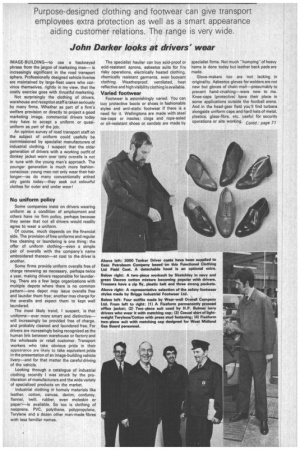John Darker looks at drivers' wear
Page 69

If you've noticed an error in this article please click here to report it so we can fix it.
IMAGE-BUILDING—to use a hackneyed phrase from the jargon of marketing men— is increasingly significant in the road transport sphere. Professionally designed vehicle liveries are maintained by large-fleet users who convince themselves, rightly in my view, that the costly exercise goes with thrustful marketing.
Not surprisingly the clothing of drivers, warehouse and reception staff is taken seriously by many firms. Whether as part of a firm's welfare provision or directly to project a good marketing image, commercial drivers today may have to accept a uniform or quasiuniform as part of the job.
An opinion survey of road transport staff on the subject of uniform could usefully be commissioned by specialist manufacturers of industrial clothing. I suspect that the older generation of drivers with a working outfit of donkey jacket worn over tatty overalls is not in tune with the young man's approach. The younger generation is much more fashionconscious: young men not only wear their hair longer—as do many conventionally attired city gents today—they seek out colourful clothes for outer and under wear!
No uniform policy
Some companies insist on drivers wearing uniform as a condition of employment and others have no firm policy, perhaps because they sense that not all drivers would readily agree to wear a uniform.
Of course, much depends on the financial side. The provision of free uniforms and regular free cleaning or laundering is one thing; the offer of uniform clothing—eNien a simple pair of overalls with the company's name embroidered thereon—at cost to the driver is another.
Some firms provide uniform overalls free of charge renewing as necessary, perhaps twice a year, making drivers responsible for laundering. There are a few large organizations with multiple depots where there is no common pattern—one depot may issue overalls free and launder them free; another may charge for the overalls and expect them to kept well laundered.
The most likely trend, I suspect, is that uniforms—ever more smart and distinctive— will increasingly be provided free of charge, and probably cleaned and laundered free. For drivers are increasingly being recognized as the human link between warehouse or factory and the wholesale or retail customer. Transport workers who take obvious pride in their appearance are likely to take equivalent pride in the presentation of an image-building vehicle livery—and for that matter the careful driving of the vehicle.
Looking through a catalogue of industrial clothing recently I was struck by the proliferation of manufacturers and the wide variety of specialized products on the market.
Industrial clothing in homely materials like leather, cotton, canvas, denim, corduroy, flannei, twill, rubber, even moleskin or paperl—is available. So too is clothing of neoprene. PVC, polythene, polypropylene. Terylene and a dozen other man-made fibres with less familiar names. The specialist haulier can buy acid-proof or acid-resistant aprons, asbestos suits for fire risky operations, electrically heated clothing, chemically resistant garments, even buoyant clothing. Weatherproof. ventilated, heat reflective and high visibility clothing is available.
Varied footwear
Footwear is astonishingly varied. You can buy protective boots or shoes in fashionable styles and anti-static footwear if there is a need for it. Wellingtons are made with steel toe-caps or insoles: clogs and rope-soled or oil-resistant shoes or sandals are made by
specialist firms. Not much -humping" of heavy items is done today but leather back pads are made.
Glove-makers too are not lacking in originality. Asbestos gloves for welders are not new but gloves of chain-mail—presumably to prevent hand-crushing—were new to me. Knee-caps (protective) have their place in some applications outside the football arena. And in the head-gear field you'll find turbans alongside uniform caps and hard hats of metal, plastics, glass-fibre, etc, useful for security operations or site working. Contd.: page 71


























































































































